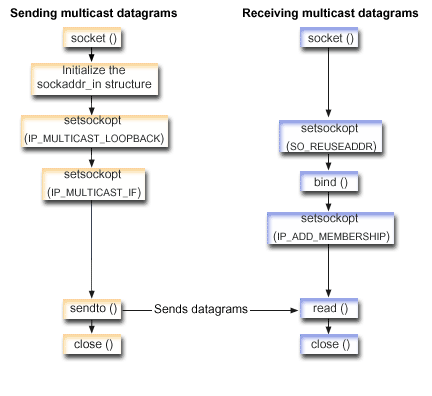IP multicasting provides the capability for an application to send a single IP datagram that a group of hosts in a network can receive.
The hosts that are in the group might reside on a single subnet or on different subnets that connect multicast-capable routers. Hosts might join and leave groups at any time. There are no restrictions on the location or number of members in a host group. A class D IP address in the range 224.0.0.1 to 239.255.255.255 identifies a host group.
An application program can send or receive multicast datagrams by using the socket() API and connectionless SOCK_DGRAM type sockets. Multicasting is a one-to-many transmission method. You cannot use connection-oriented sockets of type SOCK_STREAM for multicasting. When a socket of type SOCK_DGRAM is created, an application can use the setsockopt() function to control the multicast characteristics associated with that socket. The setsockopt() function accepts the following IPPROTO_IP level flags:
- IP_ADD_MEMBERSHIP: Joins the multicast group specified.
- IP_DROP_MEMBERSHIP: Leaves the multicast group specified.
- IP_MULTICAST_IF: Sets the interface over which outgoing multicast datagrams are sent.
- IP_MULTICAST_TTL: Sets the Time To Live (TTL) in the IP header for outgoing multicast datagrams.
- IP_MULTICAST_LOOP: Specifies whether a copy of an outgoing multicast datagram is delivered to the sending host as long as it is a member of the multicast group.

Socket flow of events: Sending multicast datagrams
The following sequence of the socket calls provides a description of the graphic. It also describes the relationship between two applications that send and receive multicast datagrams. The first example uses the following sequence of function calls:
- The socket() function returns a socket descriptor representing an endpoint. The statement also identifies that the INET (Internet Protocol) address family with the TCP transport (SOCK_DGRAM) is used for this socket. This socket sends datagrams to another application.
- The sockaddr_in structure specifies the destination IP address and port number. In this example, the address is 225.1.1.1 and the port number is 5555.
- The setsockopt() function sets the IP_MULTICAST_LOOP socket option so that the sending system does not receive a copy of the multicast datagrams it transmits.
- The setsockopt() function uses the IP_MULTICAST_IF socket option which defines the local interface over which the multicast datagrams are sent.
- The sendto() function sends multicast datagrams to the specified group IP addresses.
- The close() function closes any open socket descriptors.
Socket flow of events: Receive multicast datagrams
The second example uses the following sequence of function calls:
- The socket() function returns a socket descriptor representing an endpoint. The statement also identifies that the INET (Internet Protocol) address family with the TCP transport (SOCK_DGRAM) is used for this socket. This socket sends datagrams to another application.
- The setsockopt() function sets the SO_REUSEADDR socket option to allow multiple applications to receive datagrams that are destined to the same local port number.
- The bind() function specifies the local port number. In this example, the IP address is specified as INADDR_ANY to receive datagrams that are addressed to the multicast group.
- The setsockopt() function uses the IP_ADD_MEMBERSHIP
socket option which joins the multicast group that receives the datagrams.
When joining a group, specify the class D group address along with the IP
address of a local interface. The system must call the IP_ADD_MEMBERSHIP socket
option for each local interface receiving the multicast datagrams. In this
example, the multicast group (225.1.1.1) is joined on the local 9.5.1.1 interface.
Note: IP_ADD_MEMBERSHIP option must be called for each local interface over which the multicast datagrams are to be received.
- The read() function reads multicast datagrams that are being sent..
- The close() function closes any open socket descriptors.